Kick turns er et must-know triks for oppoverkjøring, spesielt når du navigerer bratt eller trangt terreng. Ideen? Bytt retning uten å miste terreng eller skli bakover. Slik gjør du det: du svinger én ski om gangen, med staver for balanse. Høres vanskelig ut? Det kan det være, men med øvelse og riktig utstyr er det helt gjennomførbart.
Hvorfor spiller utstyret noen rolle? Lange ski kan føles klumpete og vanskelige å håndtere i trange områder. Der kommer kortere, lette alternativer som Snowfeet Skiblades (65-120 cm) eller WALKSKI Touring Skis (100 cm) inn. Disse er lettere å svinge rundt, mindre slitsomme, og perfekte for nybegynnere som lærer seg teknikken.
Raske tips for kick turns:
- Pakk snøen under skiene for en stabil base.
- Bruk staver som et stativ for balanse.
- Løft og sving én ski om gangen – ikke hast.
- Øv på mildere bakker før du tar fatt på brattere.
Kortere ski gjør læringen raskere og hjelper deg å unngå vanlige feil, som å hekte seg fast i hindringer eller miste balansen. Hvis du er ny på oppoverkjøring eller bare vil gjøre livet enklere i bakkene, kan det å investere i kortere ski bli en game-changer. La oss bryte det ned steg for steg.
Enkel Kick Turn-teknikk for skiturer
Trinnvis guide til å mestre Kick Turns
Lær hvordan du mestrer kick turns steg for steg, så du trygt kan håndtere bratt terreng med letthet.
Forberedelse til Kick Turn
Før du prøver en kick turn, er det et must å sette opp et solid fundament. Denne forberedelsesfasen skiller en jevn, kontrollert sving fra et ustøtt forsøk som kan ende i et snubling.
Start med å komprimere snøen under skiene dine. Dette skaper en stabil plattform – spesielt viktig når du har med isete eller vindpakket snø å gjøre. Det kan virke som et ekstra steg, men det kan utgjøre hele forskjellen mellom å holde seg oppreist og å miste balansen.
Plasser deretter nedover-staven oppover og litt bak deg for ekstra stabilitet og løft. Begge stavene bør holdes over skinnesporet for å hjelpe deg med balansen. I motsetning til enklere oppover kick turns, er stangplasseringen her kritisk.
Tenk på stavene dine som bena til et stativ – de er støttesystemet ditt. Bruk dem til å fordele vekten jevnt mellom stavene og oppover-skien. Plant dem fast for hvert steg for å opprettholde balansen.
Hvis du bruker Snowfeet*-modeller, gjør deres kortere, lettere design denne prosessen enklere. Med balansen på plass, er du klar til å takle selve svingen.
Utføre Kick Turn
Når plattformen din er stabil, er det tid for å ta svingen. Nøkkelen her? Tålmodighet og kontroll. Å skynde seg øker bare sjansen for å miste balansen.
Start med å løfte nedover-skien og vri den mot din nye retning. Når du setter den ned, sikte på en posisjon nær 90° på tvers av fallinjen. Dette gir deg en stabil base å flytte vekten over på.
Ta en pause et øyeblikk for å bekrefte balansen før du går videre. Hvis du føler deg ustø, juster ved å flate ut skien.
Med vekten sikkert på den første skien, løft oppover-skien og sving den rundt for å matche. Denne andre bevegelsen skal føles lettere nå som du er stabil og på linje.
For brattere, mer teknisk terreng er snap-kick svinger ditt valg. Disse innebærer raske, avgjørende bevegelser, som reduserer tiden du tilbringer i en ustabil posisjon.
Vanlige utfordringer og hvordan overvinne dem
Selv med trinnene på plass, er det noen vanlige småproblemer som kan kaste deg av. En stor feil? Å skynde seg gjennom svingen eller hoppe over forberedelsene. Uten riktig stangplassering prøver du i praksis å balansere på ett ben mens du manøvrerer en lang ski i en bakke – ikke ideelt.
Et annet problem er å ikke skape en stabil plattform før du starter. Hvis skiene dine sklir eller snøen under deg er løs, vil ikke engang feilfri teknikk redde deg. Ta deg tid til å pakke snøen og sette deg opp for suksess.
Tvil er en annen vanlig hindring. Å være usikker kan føre til fall. Å øve på mildere bakker kan hjelpe deg med å bygge den selvtilliten du trenger når du beveger deg til brattere terreng.
Tradisjonelle lange ski kan gjøre ting vanskeligere. Lengden forsterker selv små feil og gjør dem til større problemer. På den annen side er Snowfeet* Skiblades eller WALKSKI-modeller mer tilgivende. Deres kompakte størrelse minimerer momentproblemer og reduserer risikoen for å hekte seg på steiner eller trær. Dette gjør dem til et flott valg for jevnere, mer kontrollerte svinger, selv i trange eller vanskelige områder.
Tips for å forbedre balanse og kontroll
Å mestre kick turns starter med å bygge kjernestyrke og beherske ferdighetene som gjør oppoverkjøring jevnere.
Bygge bedre balanse og stabilitet
God balanse er ryggraden i en solid kick turn. Når du svinger på én ski og flytter den andre, balanserer du egentlig på en glatt, vinklet overflate. Det er vanskelig, men med øvelse kan du få taket på det.
Start enkelt: øv på flatt underlag. Stå på ett ben i omtrent 30 sekunder, og legg deretter til skistavene for ekstra støtte. Når du er stødig, prøv det samme på pakket snø mens du har på ski. Denne trinnvise tilnærmingen hjelper musklene dine å huske hva de skal gjøre når du er i brattere terreng.
Her er et viktig tips: hold vekten sentrert over støtteskien din. Ikke len deg for langt oppover eller nedover – hold balansen og la kjernen gjøre jobben mens lemmer justerer seg.
Hvis du bruker tradisjonelle alpinski (160–180 cm), kan små feil føles store. Kortere alternativer som Snowfeet* Skiblades (65, 99 eller 120 cm) er mer tilgivende og enklere å kontrollere.
Ankelmobilitet er en annen brikke i puslespillet. Stive ankler kan ødelegge balansen din og tvinge bena til å overkompensere. Løsne opp med noen ankel-sirkler og leggstrekk før du går i bakken. Fleksible ankler fungerer som støtdempere og hjelper deg å tilpasse deg ujevn snø uten å miste stabiliteten.
Når balansen din er solid, er det på tide å fokusere på støtte-teknikker for å øke kontrollen.
Bruke støtte-teknikker
Bedret balanse er flott, men å kombinere det med sterke støtte-teknikker tar kick turns til neste nivå. Skistaver er dine beste venner her. Bruk dem som anker under vanskelige manøvrer – plant dem fast i stedet for bare å duppe i snøen. Dette gir deg ekstra stabilitet i de mest ustabile øyeblikkene.
På bratte eller isete bakker kan du vurdere side-steg. Løft én ski om gangen og plasser den litt oppover for å lage en trapp-effekt. Det er tregere enn kick turns, men passer godt med Snowfeet* takket være deres lettere, kortere design.
For moderate bakker er sildebens-teknikken et solid valg. Plasser skiene i en V-form med tuppene pekende utover. Dette lar innsiden av kantene gripe snøen, og fordeler vekten jevnt over begge ski. Snowfeet*-modeller, med sine kortere profiler, gjør sildebensstegene jevnere og mindre slitsomme over lengre strekninger.
Noen ganger fungerer det best å blande teknikker. Start med side-steg for å få selvtillit, og bytt deretter til kick turns når terrenget blir lettere. Å tilpasse tilnærmingen din til snøen og bakken holder deg i kontroll.
Tradisjonelle lange ski kan gjøre disse støtteteknikkene klønete og slitsomme på grunn av ekstra lengde og vekt. Snowfeet* WALKSKI Backcountry Touring Ski (100 cm) treffer en flott balanse - de er lange nok for effektiv gli, men korte nok til å gjøre oppoverbevegelser mindre krevende.
sbb-itb-17ade95
Hvorfor Snowfeet* Produkter Er Ideelle for Kick Turns
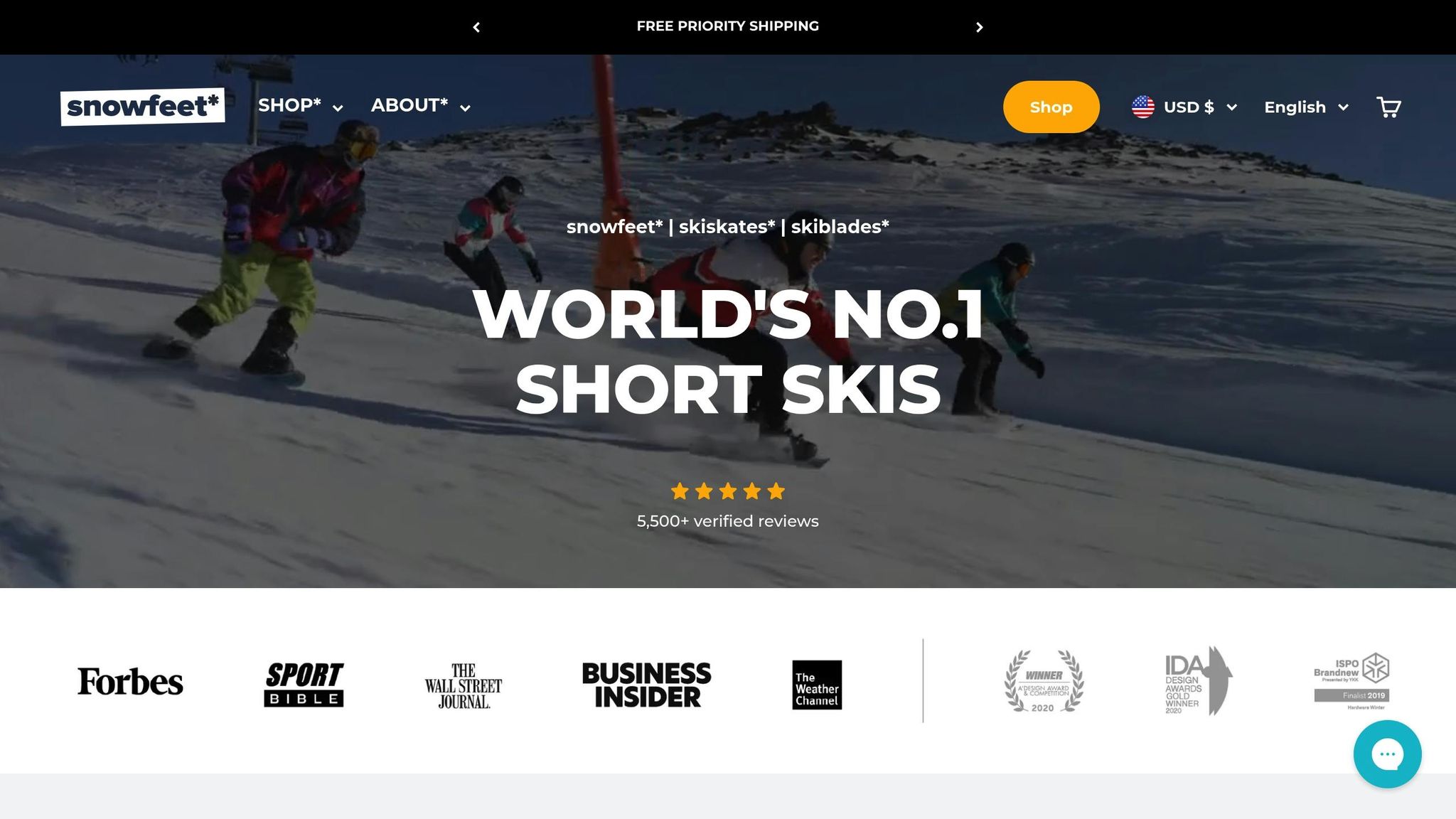
Når du takler bratte bakker eller navigerer i trangt terreng, kan valget av utstyr utgjøre hele forskjellen. Snowfeet* produkter gir en unik fordel over tradisjonelle lange ski, spesielt for kick turns og oppoverbakke. La oss se nærmere på hvorfor de er en slik game-changer.
Sammenligning av Snowfeet* med Tradisjonelt Utstyr
Tradisjonelle alpinski, vanligvis 160–180 cm lange, kan være et virkelig problem i trange områder hvor presise bevegelser er avgjørende. Her skinner Snowfeet* virkelig. Deres kortere lengder - Skiblades på 65 cm, 99 cm og 120 cm - gjør det mye enklere å svinge under kick turns. Tenk deg å prøve å manøvrere en 6-fots ski i et trangt rom kontra noe som er halvparten så stort. Med kortere ski er det mindre tupp og hale å bekymre seg for at skal hekte seg fast i steiner, trær eller andre hindringer.
Vekt er en annen stor faktor. Tradisjonelle alpinski, kombinert med tunge tursko, kan tømme deg for krefter på lange oppstigninger. Snowfeet* produkter, derimot, er lette og fungerer med vanlige vintersko. Denne kombinasjonen reduserer ikke bare tretthet, men gjør også oppoverbakke enklere og mer presis. Enten det er smale rygger eller trange hårnålssvinger, gir Snowfeet* utstyr raske, kontrollerte bevegelser, der tradisjonelle ski ofte krever brede, sveipende svinger.
Ta for eksempel Snowfeet* WALKSKI Backcountry Touring Ski på 100 cm. De treffer en perfekt balanse: lange nok for effektiv gli på åpent terreng, men korte nok til å håndtere vanskelige partier med letthet. I tillegg gjør fleksibiliteten ved å bruke dine egne vintersko at du kan fokusere på å mestre kick turns uten å slite med ukjent, klumpete fottøy.
Hvordan Snowfeet* Gjør Læringen Enklere
Utover utstyrsfordelene gjør Snowfeet* det også enklere å mestre kick turns. Tradisjonelle lange ski kan gjøre læringen til en skremmende utfordring, med en bratt læringskurve og tøffere konsekvenser ved feil.
Med Snowfeet*, bygges selvtilliten raskere. På 180 cm ski kan et lite feiltrinn under en kick turn kaste deg ut av balanse i flere sekunder. Men med 99 cm Skiblades er det mye lettere å hente seg inn igjen etter de samme feilene, slik at du kan fokusere på å forbedre teknikken i stedet for å stadig rette på deg selv.
Øvelse blir også mer tilgjengelig. Snowfeet* produktene er bærbare og allsidige, noe som gjør dem perfekte for å øve på steder hvor tradisjonelle ski ikke fungerer – som i hagen din, lokale bakker eller til og med pakket snø på turstier. Kortere ski trener også kroppen til å gjøre raskere, mer presise bevegelser, og bygger muskelminne som er annerledes enn de brede, sveipende bevegelsene som kreves av lange ski.
Og la oss ikke overse faktoren frykt. Lange ski kan føles skremmende, spesielt i brattere bakker hvor kontroll er vanskeligere å opprettholde. Snowfeet* sin kortere design gjør det enklere å stoppe og justere, noe som gir nybegynnere selvtillit til å takle brattere terreng raskere. Denne raskere læringskurven betyr at du snart er klar for mer utfordrende oppoverbakker.
Velge riktig Snowfeet* modell for oppoverbakke
Å velge riktig Snowfeet* modell avhenger av ditt ferdighetsnivå, terrenget du skal takle, og dine overordnede mål. Hver modell er designet med spesifikke egenskaper som gjør oppoverbakke og kick turns mer effektive. La oss gå gjennom hvilken modell som passer best for ulike typer terreng.
Matchende Snowfeet* Modeller til Terreng
Snowfeet Mini Ski Skates (38 cm / 15 in)
Disse kompakte skøytene er perfekte for å navigere trangt, teknisk terreng. Med en lengde på litt over 15 tommer er de enkle å håndtere på smale rygger, gjennom tette trær eller på bratte svinger. Nybegynnere vil sette pris på hvor håndterbare de er for å lære kick turns. De passer imidlertid best for kortere stigninger på pakket snø og er ikke ideelle for dyp pudder eller lange turer.
65 cm Skiblades
Leter du etter noe allsidig? 65 cm Skiblades balanserer smidighet og ytelse. Størrelsen gjør kick turns lette, samtidig som de gir bedre flyt i myk snø og solid stabilitet på moderate bakker.
99 cm Skiblades (omtrent 39 in)
Hvis du planlegger lengre turer i villmarken, er denne modellen et godt valg. Den ekstra lengden hjelper med å gli gjennom dypere snø og håndtere flatere terrengpartier. Til tross for størrelsen er de fortsatt håndterbare nok for kick turns på trangere steder, noe som gjør dem til et solid valg for middels erfarne skiløpere som utforsker variert terreng.
100 cm WALKSKI
Designet for seriøs oppoverbakke, kombinerer WALKSKI effektivitet med presisjon. Den tilpassede lengden forbedrer sporing og stabilitet på lange stigninger, noe som gjør den til et pålitelig valg for heldags eventyr i villmarken. Enten du bestiger bratte bakker eller takler vanskelige kick turns, er denne modellen bygget for utholdenhet og kontroll.
120 cm Short Skis
Erfarne skiløpere som tar fatt på bratt, teknisk terreng vil elske disse skiene. Med fokus på presisjon og ytelse er de ideelle for krevende nedkjøringer og trange manøvrer hvor nøyaktighet er avgjørende.
Priser og tilgjengelighet
En av de fremtredende fordelene med Snowfeet* er hvor rimelige og praktiske de er sammenlignet med tradisjonelle skioppsett. En komplett turrennpakke - inkludert ski, bindinger, støvler og staver - kan lett koste mellom $1,500 og $3,000 eller mer. Snowfeet* tilbyr et mye mer budsjettvennlig alternativ uten å gå på kompromiss med funksjonaliteten. Her er oversikten:
- Snowfeet Mini Ski Skates: Fra $250
- 65 cm Skiblades: Fra $635
- 99 cm Skiblades: Pris $675
- 100 cm WALKSKI Backcountry Touring Skis: Pris $675
- 120 cm Short Skis: Tilgjengelig for $775
Disse modellene er ikke bare rimeligere, men de eliminerer også mange av de løpende kostnadene knyttet til tradisjonell ski. Du trenger ikke dyre støveltilpasninger, spesialisert utstyr eller separate oppsett for tur- versus alpedager. I tillegg betyr det kompakte designet at du kan kaste dem i en vanlig ryggsekk, noe som gjør spontane eventyr enklere enn noensinne. Og med flere øvingsmuligheter har det aldri vært enklere å perfeksjonere kick turns.
Konklusjon: Mestre Kick Turns med Snowfeet*
Kick turns trenger ikke å være skremmende. Med riktig tilnærming og utstyr kan de bli en naturlig del av dine oppoverreiser. Hemmeligheten er å dele bevegelsen opp i enkle steg, øve på balansen og bruke utstyr som jobber med deg, ikke mot deg.
Det er her Snowfeet*-utstyret virkelig skinner. Tradisjonelle lange ski kan gjøre presise kick turns utfordrende, men Snowfeet*-produktene fjerner disse hindringene. Deres kortere design gir deg kontrollen du trenger for skarpe bevegelser, mens den lette konstruksjonen hjelper deg å spare energi på lange stigninger.
Snowfeet* handler ikke bare om tekniske fordeler - det handler også om praktisk bruk. Disse produktene leverer ytelse på høyt nivå uten den høye prisen som tradisjonelt turrennutstyr har. Og fordi de er så allsidige, kan du øve nesten hvor som helst det er snø - i hagen din, på en lokal bakke eller til og med på nærliggende stier. Denne tilgjengeligheten gjør det enkelt å bygge muskelminne og selvtillit før du går inn i mer krevende terreng.
Nøkkelen er å velge Snowfeet*-modellen som passer dine behov og la det gjennomtenkte designet hjelpe deg med å mestre kick turns. Med en mykere læringskurve og flere muligheter til å øve, vil du raskt se resultater. Når det gjelder oppoverbakke og trangt terreng, betyr kortere utstyr ofte jevnere fremdrift.
Så, gjør deg klar med Snowfeet*, finpuss kick turn-ferdighetene dine, og ta fatt på de bratte stigningene med selvtillit. Ditt neste snødekte eventyr venter!
Ofte stilte spørsmål
Hvorfor er Snowfeet-produkter bedre enn tradisjonelle ski for å mestre kick turns i trangt, bratt terreng?
Snowfeet-produkter skiller seg ut når det gjelder å mestre kick turns i krevende terreng. Med sin kompakte størrelse (fra 65 cm til 120 cm) tilbyr de utrolig manøvrerbarhet, noe som gjør det enklere å utføre presise svinger, selv i bratte bakker. Dette er en stor fordel for nybegynnere eller alle som ønsker å skjerpe teknikken i trange områder.
I motsetning til lange, tunge ski, er Snowfeet lette og bærbare, noe som gjør at det å klatre oppover føles mer som et eventyr enn en treningsøkt. Deres smarte design øker balanse og kontroll, og gir deg selvtilliten til å takle utfordrende forhold uten å svette. Mens tradisjonelle ski skinner ved høye hastigheter og brede svinger, bringer Snowfeet allsidighet og enkelhet til bordet, noe som gjør dem til et fantastisk valg for å mestre kick turns og håndtere vanskelige oppoverløyper.
Hva er den beste måten for nybegynnere å øve på kick turns før de tar fatt på brattere bakker?
Nybegynnere som ønsker å mestre kick turns bør starte på flatt eller lett skrånende terreng – tenk preparerte løyper eller brannveier. Disse stedene gir deg en stabil overflate å øve på å flytte vekten jevnt, kontrollere bevegelsene dine, og plassere stavene akkurat riktig for balanse.
Hvis du bruker Snowfeet-utstyr, som deres kompakte Skiblades eller WALKSKI Backcountry Touring Skis, er du heldig. Disse produktene er lette, enkle å håndtere, og designet for å øke selvtilliten. Deres manøvrerbarhet gjør oppoverreisen mindre skremmende og mye mer moro.
Hva gjør Snowfeet-modellene perfekte for å takle bratt og trang oppoverbakke?
Snowfeet-modellene handler om bekvemmelighet og ytelse pakket i en liten, lett pakke. Med størrelser fra 65 cm til 120 cm, er disse glassfiberforsterkede vidunderne bygget for å håndtere bratte og trange partier med letthet. Metallkantene? De er ikke bare til pynt – de gir deg solid grep og stabilitet, så du føler deg i kontroll selv når forholdene blir vanskelige.
I motsetning til tradisjonelle ski eller snowboard, er Snowfeet mye enklere å bære med seg og mye mer smidige. Skal du oppover? Ikke noe problem. Deres kompakte og bærbare design gjør det lekende lett, uansett ferdighetsnivå. De er den perfekte blandingen av funksjonalitet og enkelhet, ideelle for å takle teknisk terreng uten bry.







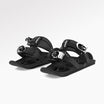













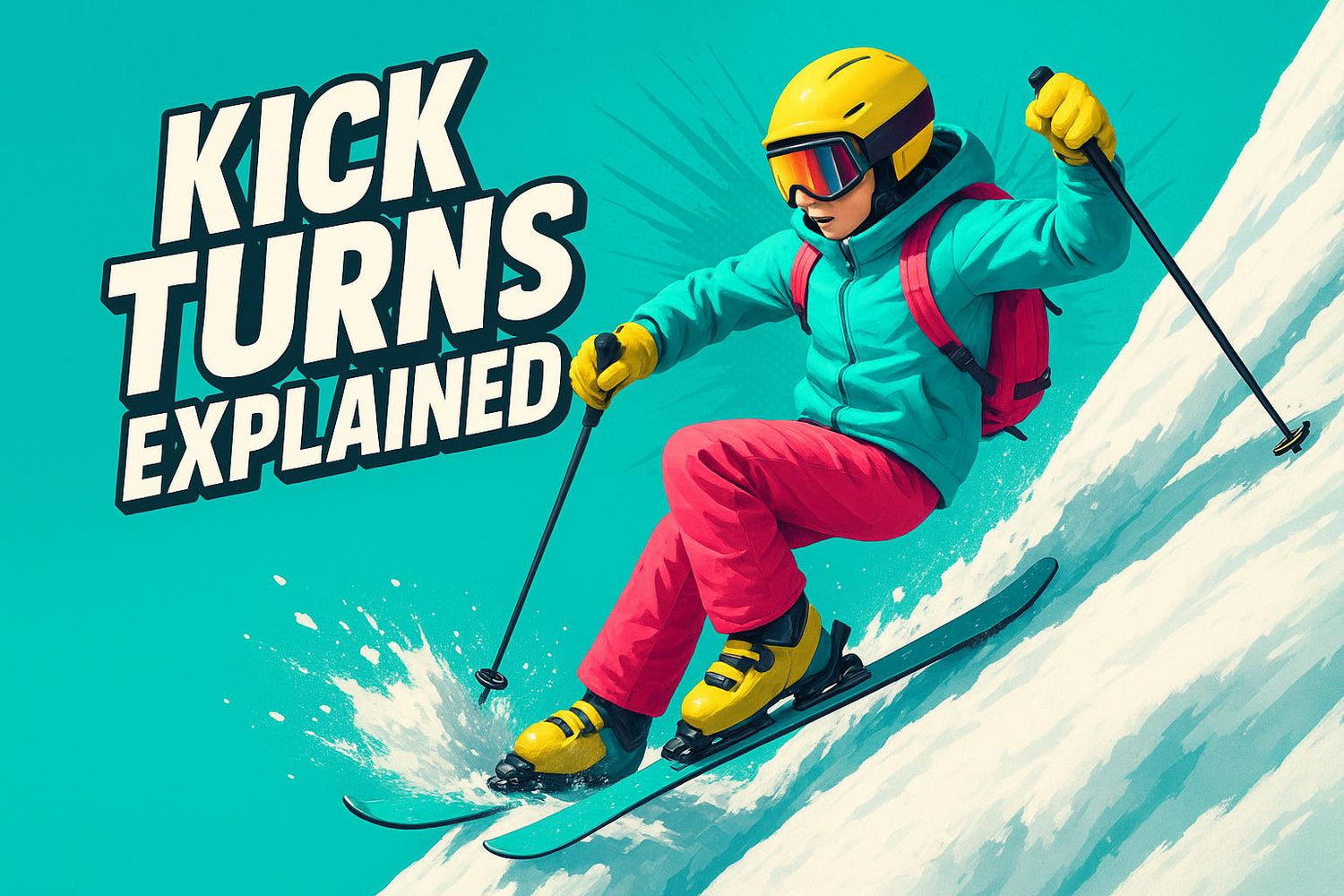
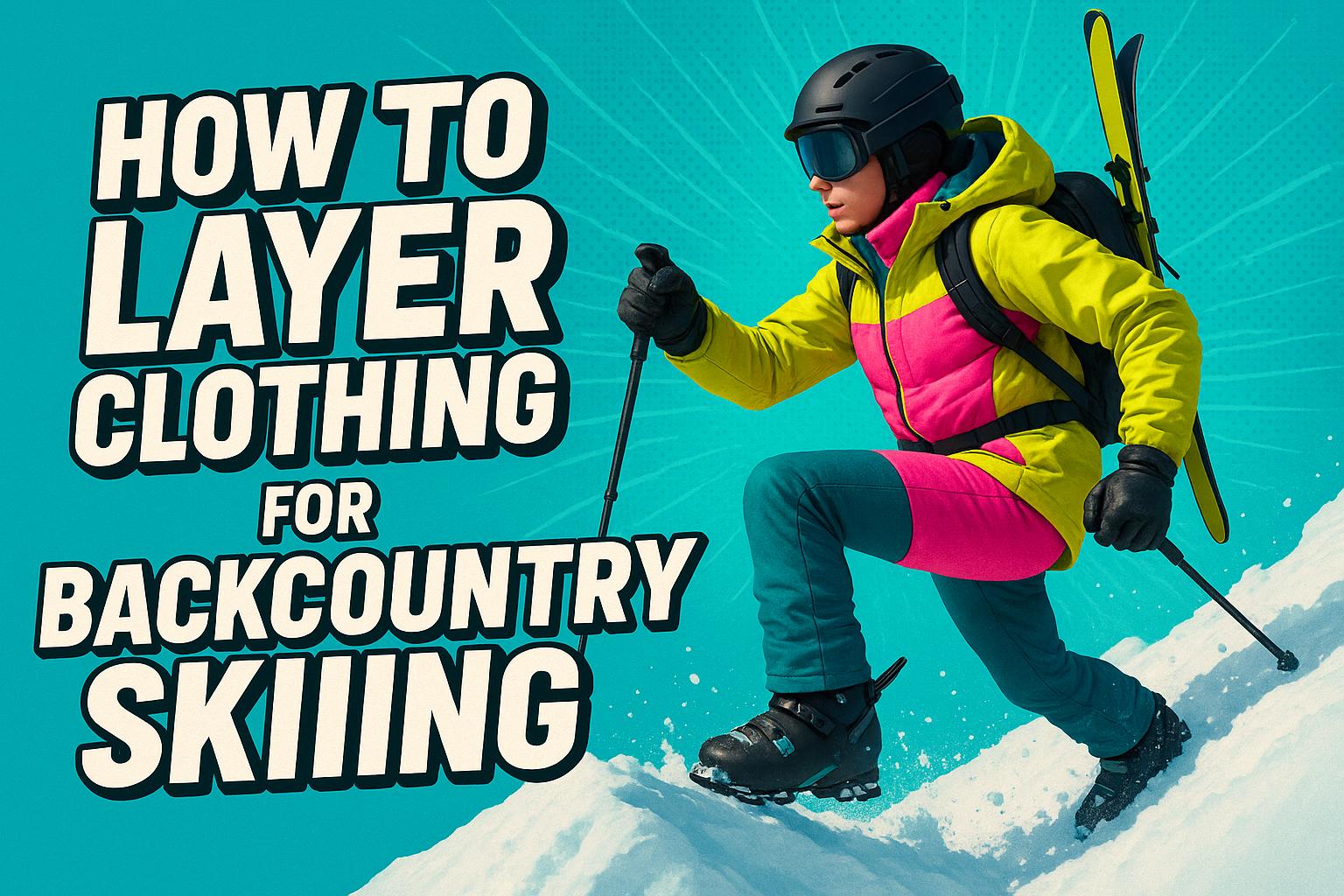
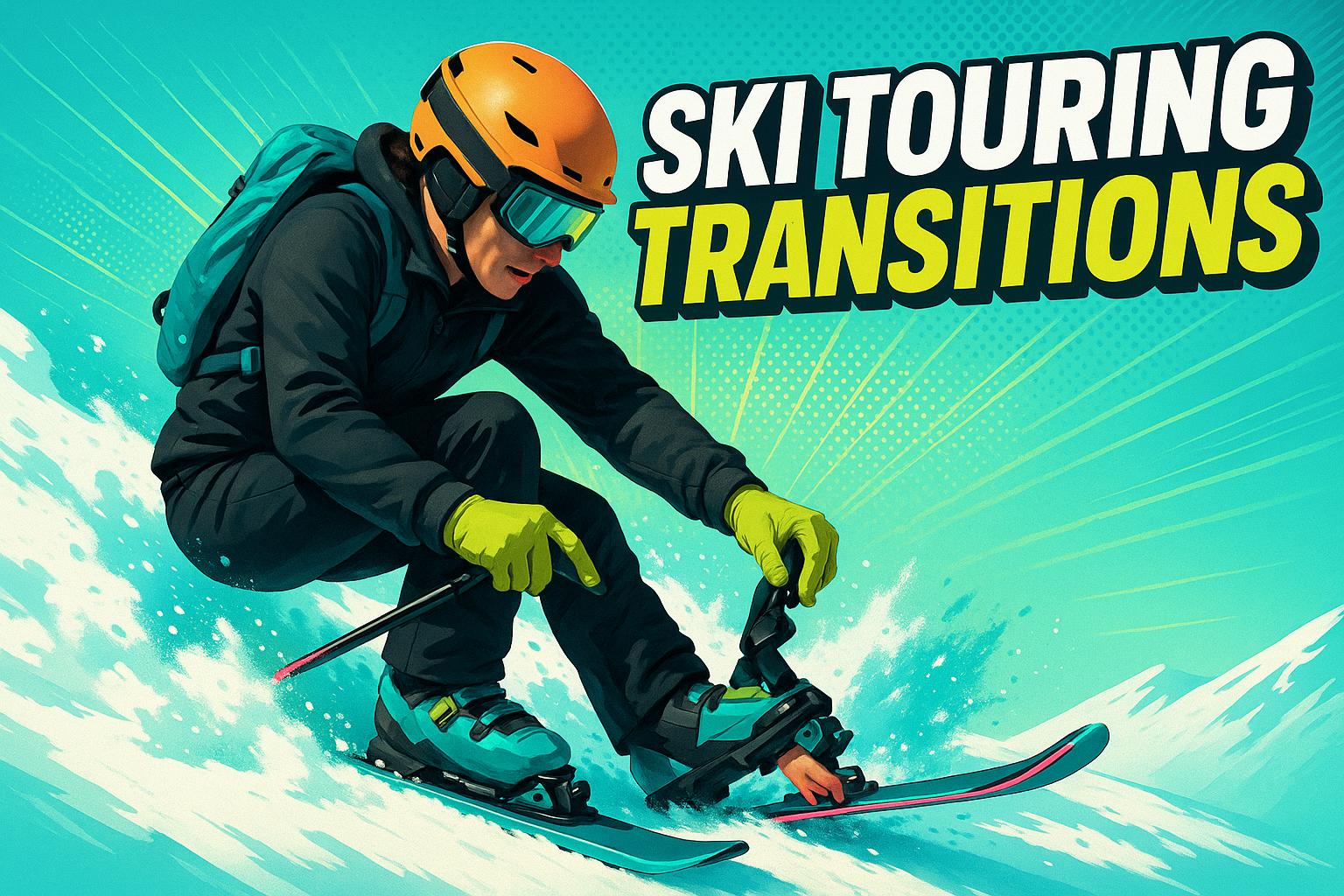




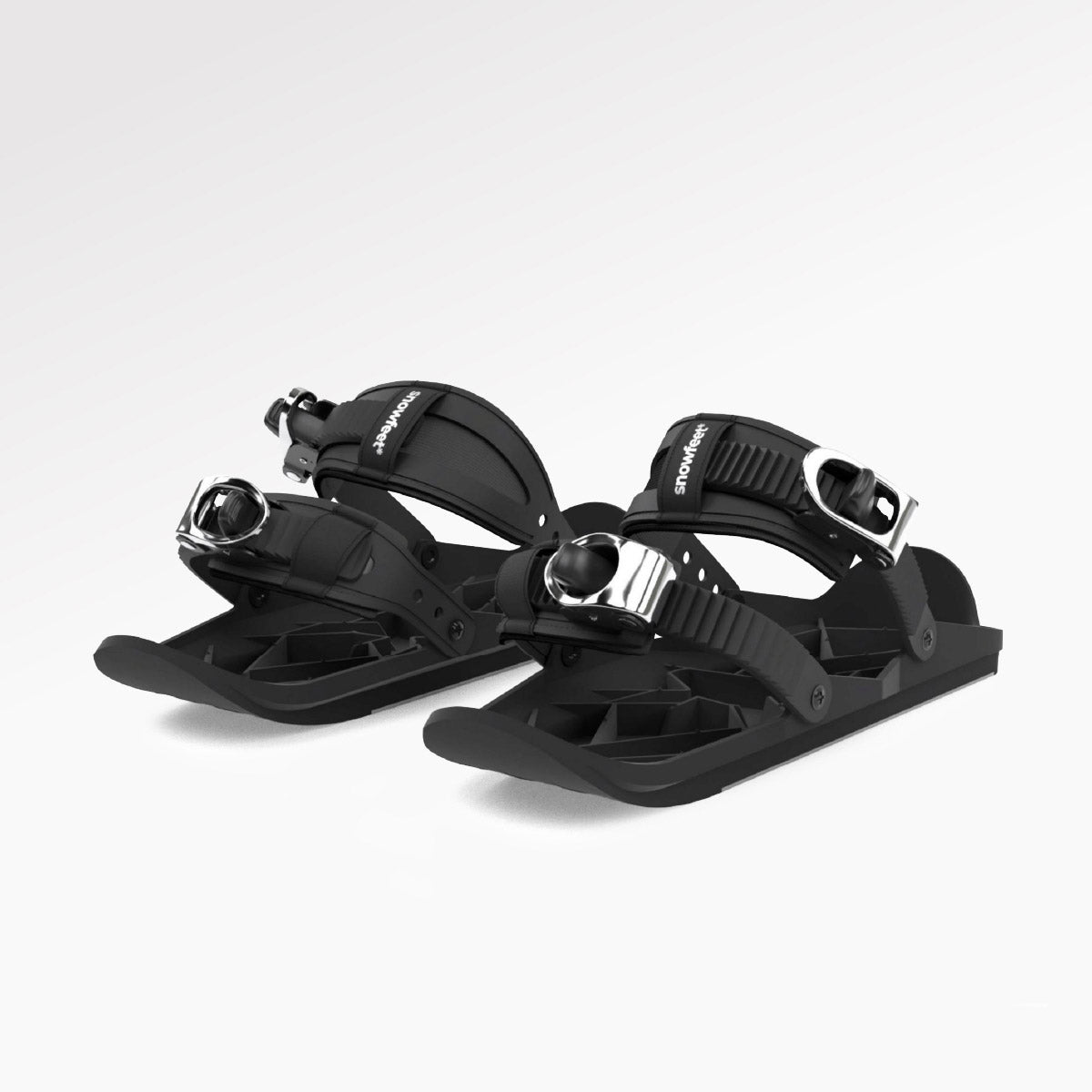
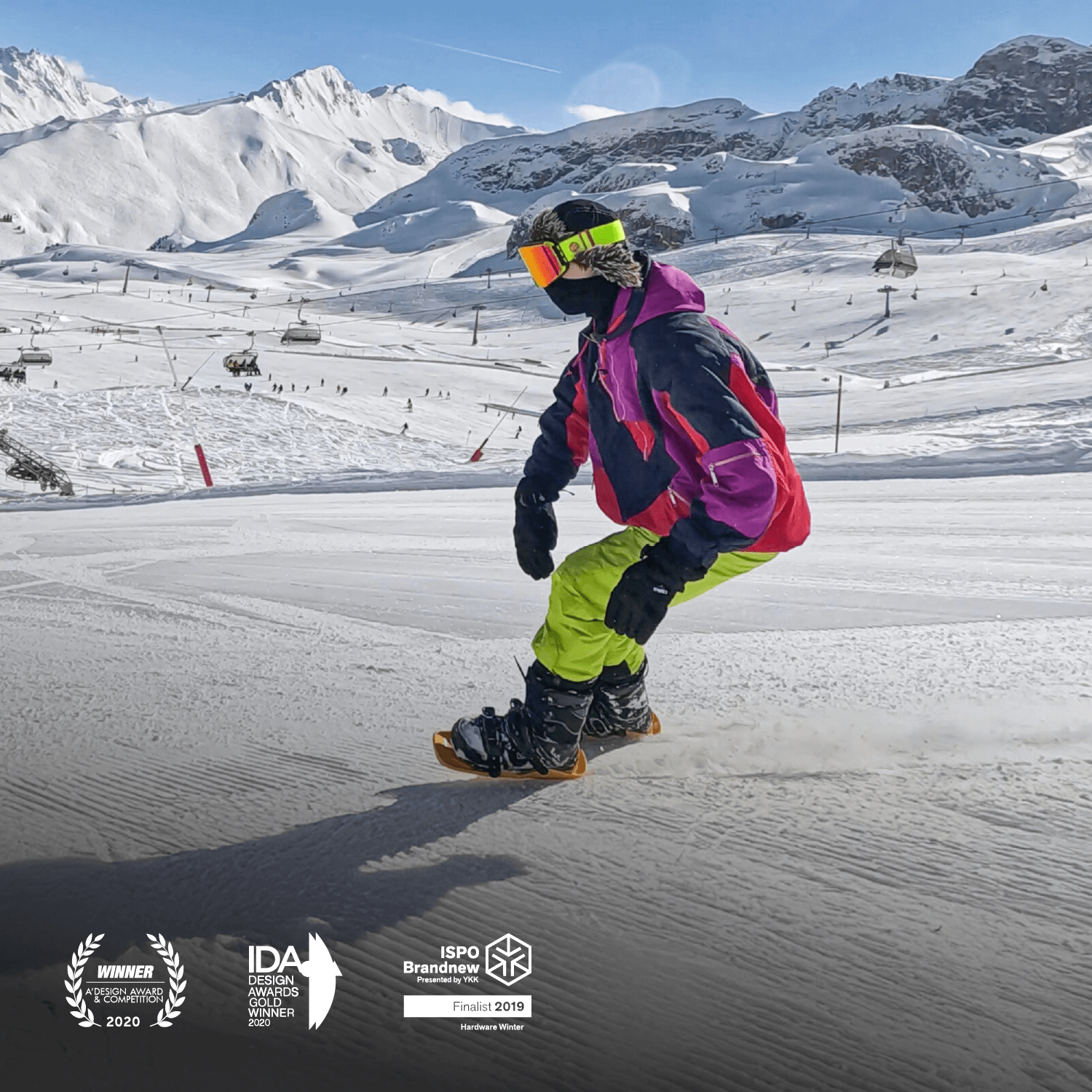




Legg igjen en kommentar
This site is protected by hCaptcha and the hCaptcha Privacy Policy and Terms of Service apply.